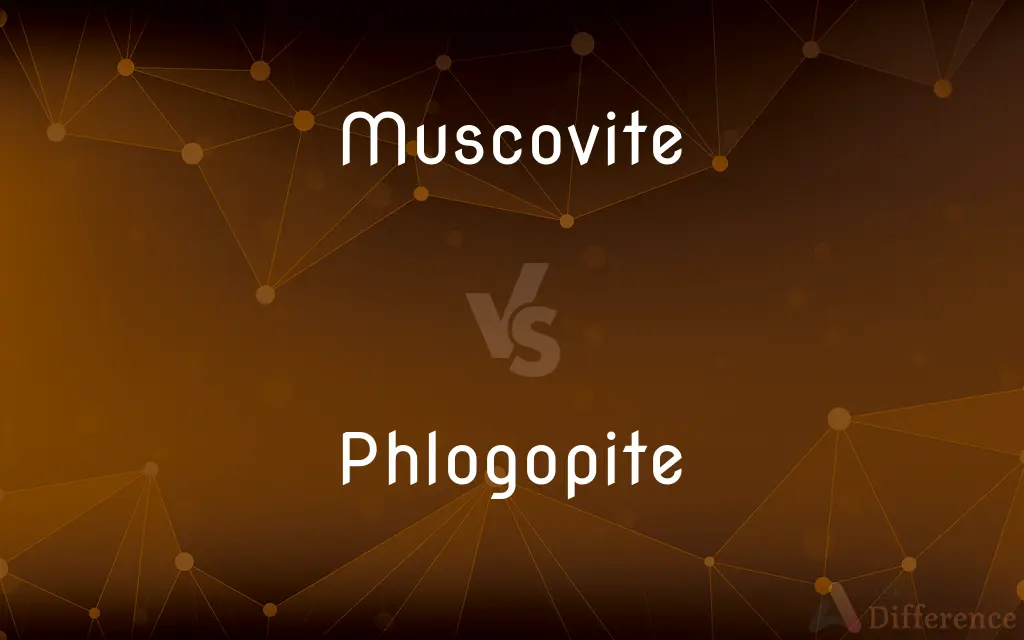Muscovite vs. Phlogopite — What's the Difference?
By Urooj Arif & Maham Liaqat — Updated on April 25, 2024
Muscovite, a pale-colored mica, is common in continental crust and valued for its electrical insulating properties; phlogopite, darker and magnesium-rich, is typically found in metamorphic rocks and known for its thermal resistance.

Difference Between Muscovite and Phlogopite
Table of Contents
ADVERTISEMENT
Key Differences
Muscovite is usually light-colored, often silvery or white, which makes it easily distinguishable in rocks. Whereas phlogopite tends to have a darker hue, ranging from brown to black, due to its higher magnesium content.
The chemical composition of muscovite includes more aluminum and less magnesium, making it more prevalent in felsic rocks like granite and pegmatite. On the other hand, phlogopite contains more magnesium, making it common in metamorphic rocks such as marble.
Muscovite is known for its excellent electrical insulation properties, which makes it useful in various industrial applications, including electronics. Meanwhile, phlogopite excels in thermal resistance and is often used in applications where heat stability is crucial.
Muscovite can withstand high electrical voltages, which adds to its value in electrical insulators and components. Conversely, phlogopite is utilized in situations requiring resistance to high temperatures, such as in furnace windows.
Muscovite tends to form in larger, well-formed sheets which are highly flexible and elastic. Conversely, phlogopite, while also forming in sheets, often displays these characteristics to a lesser degree and is generally less flexible than muscovite.
ADVERTISEMENT
Comparison Chart
Color
Light, silvery or white
Dark, brown to black
Chemical Composition
High in aluminum, low in magnesium
Low in aluminum, high in magnesium
Common Uses
Electrical insulators, electronics
Thermal insulation, furnace windows
Thermal Properties
Good electrical insulator
Excellent thermal resistance
Physical Form
Forms large, flexible sheets
Forms sheets, less flexible
Compare with Definitions
Muscovite
Forms in well-defined sheets.
The muscovite crystals were so large and clear that they could be peeled off in layers.
Phlogopite
Less flexible than other micas.
Phlogopite sheets are stiffer, making them less ideal for some flexible applications.
Muscovite
A pale mica mineral with excellent insulating properties.
Muscovite sheets are used in window panes of outdated wood stoves due to their insulating properties.
Phlogopite
Used in heat-resistant applications.
Phlogopite's thermal stability makes it suitable for high-temperature insulation.
Muscovite
Commonly found in continental crust rocks.
The granite sample contains abundant muscovite, giving it a sparkly appearance.
Phlogopite
A dark mica mineral noted for its thermal resistance.
Phlogopite is used in furnace window manufacturing due to its ability to withstand high temperatures.
Muscovite
Used in industrial and cosmetic applications.
Ground muscovite is used as a shiny additive in many cosmetic products.
Phlogopite
Typically found in metamorphic rocks like marble.
The marble quarry is known for its significant deposits of phlogopite.
Muscovite
Highly resistant to electricity.
Muscovite's resistance to electric currents makes it ideal for electronic insulation.
Phlogopite
Contains higher amounts of magnesium.
The darker color of phlogopite is due to its higher magnesium content compared to other micas.
Muscovite
Muscovite (also known as common mica, isinglass, or potash mica) is a hydrated phyllosilicate mineral of aluminium and potassium with formula KAl2(AlSi3O10)(F,OH)2, or (KF)2(Al2O3)3(SiO2)6(H2O). It has a highly perfect basal cleavage yielding remarkably thin laminae (sheets) which are often highly elastic.
Phlogopite
Phlogopite is a yellow, greenish, or reddish-brown member of the mica family of phyllosilicates. It is also known as magnesium mica.
Muscovite
A native or resident of Moscow or Muscovy.
Phlogopite
A yellow to dark brown mica, K(Mg,Fe)3AlSi3O10(OH)2, used in insulation.
Muscovite
A potassium aluminum silicate mineral, KAl2(AlSi3O10)(OH)2, the most common form of mica, which ranges from colorless or pale yellow to gray and brown, has a pearly luster, and is used as an insulator. Also called white mica.
Phlogopite
(mineral) A mica mineral with the chemical formula KMg3AlSi3O10(F,OH)2, a basic potassium magnesium aluminosilicate, used as an insulator
Muscovite
Of or relating to Moscow, Muscovy, or the Muscovites.
Phlogopite
A kind of mica having generally a peculiar bronze-red or copperlike color and a pearly luster. It is a silicate of aluminia, with magnesia, potash, and some fluorine. It is characteristic of crystalline limestone or dolomite and serpentine. See Mica.
Muscovite
(mineral) A pale brown mineral of the mica group, being a basic potassium aluminosilicate with the chemical formula KAl2(Si3Al)O10(OH,F)2; used as an electrical insulator etc.
Phlogopite
A brown form of mica consisting of hydrous silicate of potassium and magnesium and aluminum
Muscovite
A native or inhabitant of Muscovy or ancient Russia; hence, a Russian.
Muscovite
An inhabitant of Moscow.
Muscovite
Common potash mica, essentially KAl3Si3O10(OH)2. It is used as an electrical insulator. See Mica.
Muscovite
A colorless or pale brown mica with potassium
Muscovite
A resident of Moscow
Muscovite
Of or relating to the residents of Moscow;
Muscovite street dealers
Common Curiosities
Can muscovite and phlogopite be found together in the same rock?
It is uncommon, but possible, for muscovite and phlogopite to coexist in the same rock, depending on the rock's formation conditions.
What are the environmental conditions that lead to the formation of phlogopite?
Phlogopite forms under high-temperature conditions, often in metamorphic settings like contact zones between magma and limestone.
What are the key physical properties of phlogopite that influence its industrial use?
Phlogopite's thermal resistance and ability to form in sheets are key to its use in industrial applications involving heat.
What distinguishes muscovite from other micas?
Muscovite is lighter in color and has superior electrical insulating properties compared to other micas.
What is the primary use of muscovite in industry?
Muscovite is primarily used as an electrical insulator in various industrial applications.
Why is phlogopite preferred for high-temperature applications?
Phlogopite's composition makes it highly resistant to heat, making it ideal for high-temperature applications.
How does muscovite react to chemical exposure?
Muscovite is chemically stable, resistant to most acids except hydrofluoric acid.
How does the flexibility of muscovite impact its uses?
Its flexibility makes it useful in applications requiring large, durable, yet bendable sheets.
Is muscovite considered a valuable mineral?
Yes, muscovite is valued both for its industrial applications and as a mineral specimen by collectors.
Are there synthetic alternatives to muscovite and phlogopite?
Synthetic micas and other insulating materials can mimic some properties of muscovite and phlogopite but not all.
How do geologists identify muscovite in the field?
Geologists identify muscovite by its light color, shiny luster, and cleavage into thin sheets.
What are the economic implications of mining muscovite?
Mining muscovite can be economically significant, particularly in regions where high-quality deposits are accessible and demand for industrial mica is high.
Does the presence of phlogopite affect the quality of marble?
Phlogopite can affect the color and thermal properties of marble, sometimes enhancing its aesthetic and functional value.
What mining techniques are used for extracting phlogopite?
Phlogopite is typically extracted through open-pit mining techniques, depending on the depth and nature of the deposit.
Can phlogopite be used in electrical applications like muscovite?
Phlogopite can be used in some electrical applications, but it is less effective as an insulator compared to muscovite.
Share Your Discovery

Previous Comparison
Aeroboard vs. Insulation
Next Comparison
Zenith vs. AzimuthAuthor Spotlight
Written by
Urooj ArifUrooj is a skilled content writer at Ask Difference, known for her exceptional ability to simplify complex topics into engaging and informative content. With a passion for research and a flair for clear, concise writing, she consistently delivers articles that resonate with our diverse audience.
Co-written by
Maham Liaqat













































